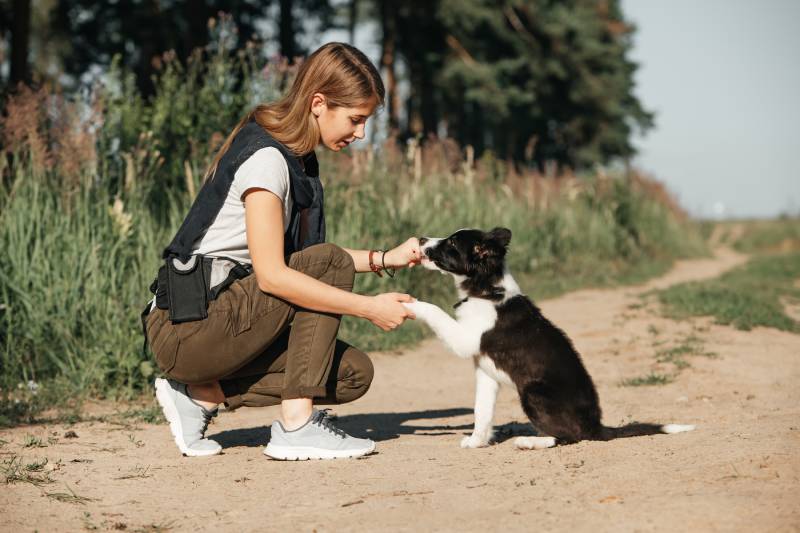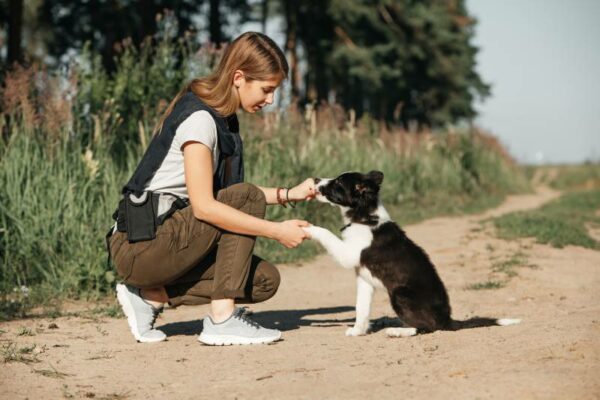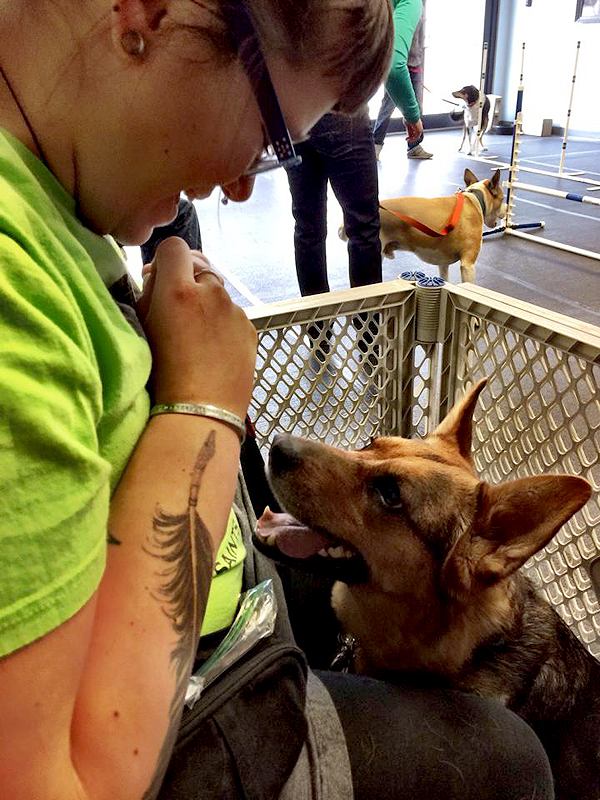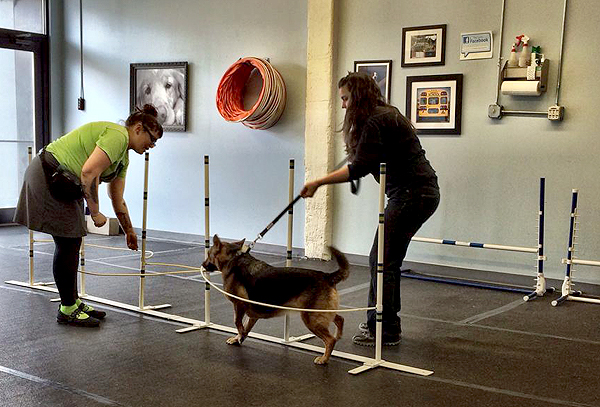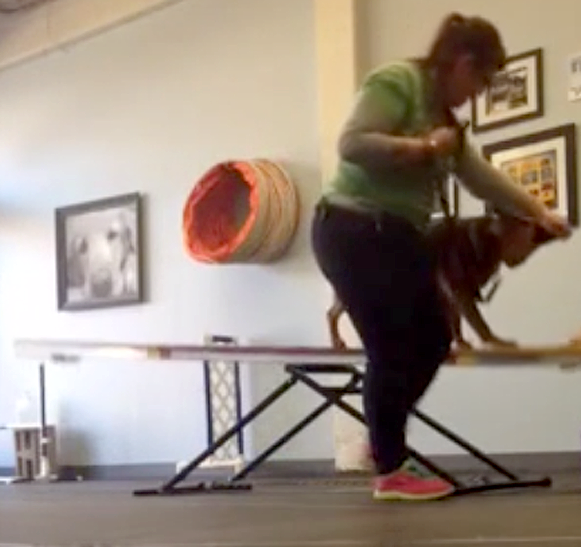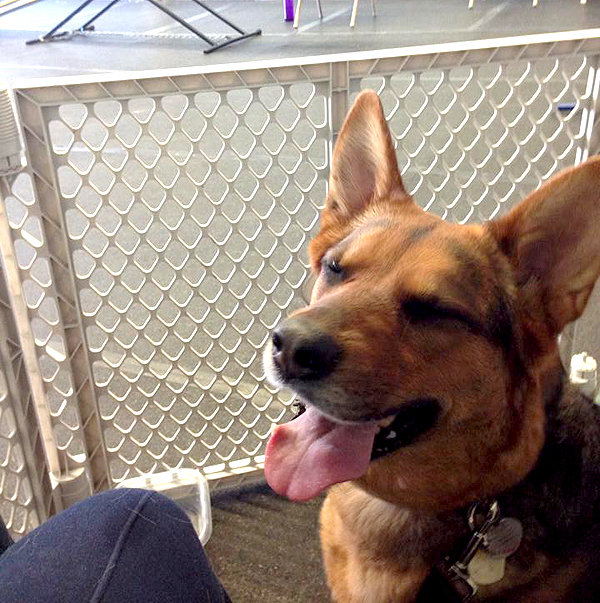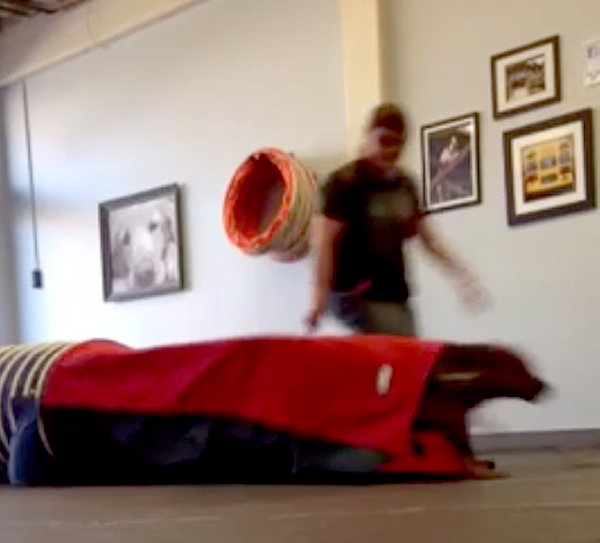My dog Charlotte had a rough start at life: Found malnourished living on the streets with a litters of puppies before her first birthday, and then narrowly missing being gassed to death at an overcrowded shelter, a rescue pulled her (and the puppies) and transported her to NYC, where my partner and I fell in love with the sad shepherd in the window of an adoption van. It’s hard to believe that it’s been two years since Charlotte first came home with us, and while there are days where she struggles more than others, I can honestly say that she has surpassed all of my expectations regarding her behavior and ability to manage her reactivity.
Having a reactive dog makes me a significantly better, more focused, and more intentional trainer. One of the challenges and benefits of having a reactive dog in the city is there’s no chance to get lazy. We don’t have a yard and so each time Charlotte leaves the apartment to potty or get exercise it’s a training opportunity. Although she’s made significant advancements in overcoming her reactivity, this winter I began strategizing with a trainer I assist for about how to provide her opportunities to continue gaining skills — specifically skills around other dogs in a controlled setting — and to give her the opportunity (ideally) to have fun learning in the presence of strange dogs.
For Charlotte, I selected a beginner agility class taught by one of the competition agility students of Frankie Joiris, the trainer who I assist for. Charlotte’s teacher, Sarah Wesmacott, runs Doggie Academy training based out of the Brooklyn Dog Training Center, and was a great trainer for Charlotte’s first classroom experience. Sarah and I exchanged several emails prior to the start of class about Charlotte’s needs, as well as my own experience with agility. She gave me the lowdown about who the other dogs in class were, and we made a plan for Charlotte to have her own little VIP corner in the back of the room with a xpen giving her space from the rest of the dogs in class.
I chose agility as Charlotte’s first exposure to a class setting because it had the benefit of being very active, which I knew would help me with keeping her focused and engaged. A benefit of living with a reactive dog in the city is that daily we have the opportunity to train, however a major downside is that we can’t control the dogs that we will encounter, and unfortunately on our daily walks we routinely encounter many dogs who bark/lunge/and otherwise react to Charlotte. My primary goal with class was to give Charlotte an environment where she could be in close proximity to other dogs who would be under control and not reacting at her.
Charlotte’s agility class was more than I’d hoped it would be, and it’s really hard to believe that the six weeks of class are already over! Charlotte had an amazing time, and the benefits from the class have been tremendous. The first week, Charlotte had a hard time settling, though she was able to perform modified versions of the exercises when it was her turn. The training room that we used is very much NYC-sized with only enough room for a couple of obstacles (in this class she learned basic familiarity with, jumps, tire, teeter, tunnel, chute, weave poles) and she learned those things with five other dogs only a few feet away from her. Going into class, my primary goal for Charlotte was to stay calm and focused enough to stay in the room. Charlotte far exceeded that goal, not only being able to stay in the classroom but each week gaining confidence and self control, building her skills, and learning to relax and have fun in a room filled with other dogs!
On the last week of class, Charlotte was even able to lay down as other dogs ran just three feet from her. She was also able to sit calmly and quietly when all her classmates rushed into a sudden chorus of barks at an unexpected dog outside the window. I almost cried as she sat quietly her goofy tongue hanging out the side of her mouth as the rest of the dogs in class barked. On the last day of class, Charlotte’s teacher made a special announcement congratulating Charlotte on how much she had grown in class.
I couldn’t have been prouder and more excited, not only because Charlotte excelled in class, but because the exposure/re-socialization/self-control skills she gained in class have had many real-world applications. Since we started class there has been a noticeable improvement in Charlotte’s reactivity to dogs she sees while out on walks in our neighborhood and in the park. Last week a neighbor took my partner aside in the elevator to say what a great job we’ve done with Charlotte, and this past weekend spring arrived in Brooklyn and my little family (along with everyone else it seemed) was out in the park. Charlotte walked past dozens of dogs, staying focused on me, finding scattered cookies on the ground and not reacting! Obviously these training successes are a result of years of consistent training, but I think it’s more than fair to say that having six weeks in class was noticeably helpful.
The 10 Tips for finding a class for your reactive pup!
1. Reasonable expectations
Having reasonable expectations for your dog enables you both to be successful and increases the safety of everyone involved.
2. Reference check
Don’t just go to any trainer, do your homework. Find out what sort of training they specialize in. What is their approach? Do they compete in dog sports? Do they have references to provide you with?
3. Communicate needs
Work with the trainer to ensure that the class will be a reasonable level and fit for your dog. I jumped a level with Charlotte because of my own experience with agility.
4. High-value treats
Always go to class armed with what your dog considers to be high value. For Charlotte that’s a combination of string cheese and turkey.
5. Stay calm
Our dogs pick up on our emotions. If you get stressed out your dog is going to get stressed, which has a tendency to increase the stress and anxiety-based unwanted behaviors you are trying to avoid.
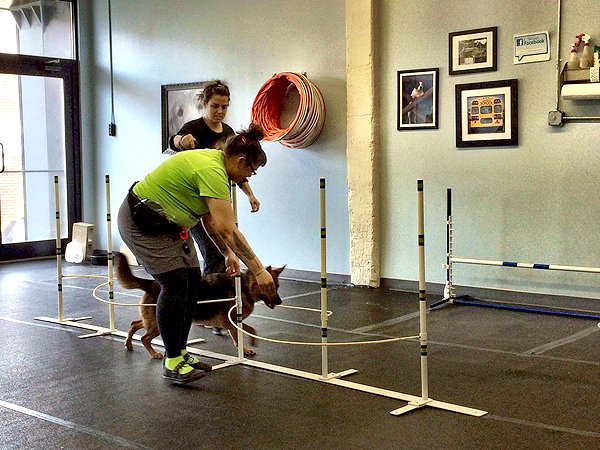
6. Don’t compare your dog to others in class
All dogs have strengths and weaknesses. Comparing your dog to other dogs in class does you both a disservice, especially if you are in the class to gain exposure and training time around reactivity.
7. Create a safe place
Work with the trainer to create space for your dog. Although the training room was very small for us, this looked like Charlotte having her own little VIP corner that was separated by an xpen. This gave a visual reminder for others in the class to give Charlotte space, it served as a barrier to keep off-leash dogs from getting near her, and enabled Charlotte to have confidence that she was safe in her little corner and didn’t need to worry about protecting it.
8. Modify exercises as needed
If others in the class are working off-leash skills, discuss with the trainer (before class) how you will modify the exercises in order to keep your dog on leash. Charlotte stayed on leash for all of the exercises that other dogs in class were performing off-leash, and I would add in some different handling to keep treats in her face and focus on me when she was struggling.
9. Keep below threshold
Set your dog up to succeed and don’t try to ask them to do something far beyond their ability by forcing them into a stressful situation that is way above their threshold. To do so is not only unfair to your dog, but it can lead to a unsafe or unpleasant situation for you, your dog, and the rest of the class.
10. Have fun!
I think this is the most important tip of all. When we don’t take ourselves (or our dogs) too seriously, when we have fun and play, our dogs are able to relax as well.
Learn more about dogs with Dogster:
- 6 Ways to Thwart an Off-Leash Dog Rushing You and Your Dog
- On Dogs and Body Language: How I Learned to “Speak” Dog
- Aspirin and Ibuprofen: Are Human Pain Meds Safe for Dogs?
Read more by Sassafras Lowrey:
- What Would You Do if Someone Kicked Your Dog On a Walk?
- Are Rescue Groups Too Strict Screening Potential Adopters?
- Warning: Dogs Are Being Electrocuted by Stray Voltage on City Sidewalks
- 6 Ways to Protect Your Dog from Dognappers
- Confession: I spent most of my Europe Tour Sniffing Out Cool Dog Things
About the author: Sassafras Lowrey is a dog-obsessed author based in Brooklyn. She is the winner of the 2013 Berzon Emerging Writer Award from the Lambda Literary Foundation, and the editor of two anthologies and one novel. Sassafras is a Certified Trick Dog Instructor, and she assists with dog agility classes. She lives with her partner, two dogs of dramatically different sizes, two bossy cats, and a kitten. She is always on the lookout for adventures with her canine pack. Learn more at her website.
Featured Image Credit: ILya Soldatkin, Shutterstock

